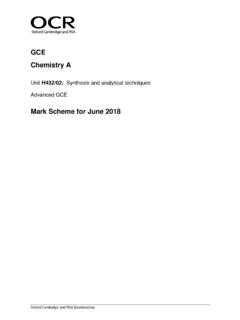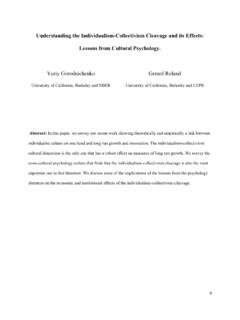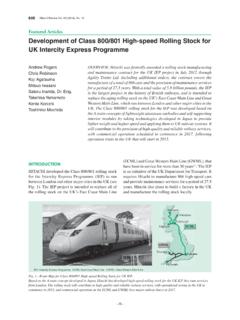Transcription of Oxford Cambridge and RSA A Level Chemistry A
1 *7011394988*INSTRUCTIONS Use black ink. You may use an HB pencil for graphs and diagrams. Complete the boxes above with your name, centre number and candidate number. Answer all the questions. Write your answer to each question in the space provided. If additional space is required, use the lined page(s) at the end of this booklet. The question number(s) must be clearly shown. Do not write in the The total mark for this paper is 100. The marks for each question are shown in brackets [ ]. Quality of extended responses will be assessed in questions marked with an asterisk (*). This document consists of 32 over OCR 2018 [601/5255/2]DC (ST/CT) 154180/4 Last nameFirst nameCandidatenumberCentrenumberOxford Cambridge and RSAA Level Chemistry AH432/02 Synthesis and analytical techniquesTuesday 12 June 2018 AfternoonTime allowed: 2 hours 15 minutesYou must have: the Data Sheet for Chemistry A(sent with general stationery)You may use: a scientific or graphical calculatorOCR is an exempt Charity*H43202*2 OCR 2018 SECTION AYou should spend a maximum of 20 minutes on this your answer to each question in the box all the Which compound is used as a standard for NMR chemical shift measurements?
2 A Si(CH3)4 B CDCl 3 C D2O D CCl 4 Your answer [1]2 Which compound is a secondary amide? ABCDHOCCH3 HONCH2 HOCCH3CH3 ONCH2H3CH3 CCCH3 HONCCH3CH3ON Your answer [1]3 Turn over OCR 20183 Which compound does not react with nucleophiles? A CH3CH2 CHO B CH3 CHCH2 C CH3CH2 COCH3 D CH3CH2CH2Cl Your answer [1]4 Which structure represents an alicyclic compound? ABCD Your answer [1]4 OCR 20185 Which molecule is not planar? A C2H4 B C2H6 C H2CO D HCN Your answer [1]6 What is the number of peaks in the 1H NMR spectrum of HOOCCH2 CHOHCH2 COOH? A 3 B 4 C 5 D 6 Your answer [1]7 Ethanol can be prepared by different reactions.
3 Which reaction has the lowest atom economy? A C6H12O6 2C2H5OH + 2CO2 B C2H4 + H2O C2H5OH C C2H5Br + H2O C2H5OH + HBr D CH3 COOC2H5 + H2O C2H5OH + CH3 COOH Your answer [1]5 Turn over OCR 20188 The breakdown of ozone is catalysed by NO radicals. Which equation is a propagation step in the mechanism for this process? A NO + O2 N + O3 B NO + O2 NO2 + O C N + O3 NO + O2 D NO2 + O NO + O2 Your answer [1]9 Which compound could have produced the IR spectrum below?transmittance (%)wavenumber / cm 104000300020001500100050050100 A CH3CH2OH B CH3 CHOHCN C CH3 COOH D CH3 CONH2 Your answer [1]6 OCR 201810 Benzene reacts with an organic reagent in the presence of a halogen carrier to form phenylethanone.
4 COCH3phenylethanone Which organic reagent is required? A CH3CH2OH B CH3 CHO C CH3 COCl D CH3 COOH Your answer [1]11 How many straight-chain structural isomers of C7H15Cl contain a chiral carbon atom? A 1 B 2 C 3 D 4 Your answer [1]7 Turn over OCR 201812 The mass spectrum of (CH3)2 CHCH2OH is shown /z010203040506070809020406080100 Which ion is responsible for the peak with the greatest relative intensity? A CHCH2OH+ B CH3CH2CH+ C (CH3)2CH+ D CH3CO+ Your answer [1]13 Which statement(s) support(s) the delocalised model for the structure of benzene? 1 All carbon carbon bonds have the same length.
5 2 The enthalpy change of hydrogenation of benzene is less exothermic than expected. 3 Bromine reacts with benzene less readily than with cyclohexene. A 1, 2 and 3 B Only 1 and 2 C Only 2 and 3 D Only 1 Your answer [1]8 OCR 201814 A solid organic compound can be purified by recrystallisation. Which statement(s) about recrystallisation is/are true? 1 The organic compound is more soluble in hot solvent. 2 The hot solution is cooled before the purified organic compound is collected. 3 The melting point of the purified organic compound is lower than the impure compound. A 1, 2 and 3 B Only 1 and 2 C Only 2 and 3 D Only 1 Your answer [1]15 Which of the following could react with the compound below to form a carbon carbon bond?
6 HBrCOOHC 1 CH3Cl and Al Cl 3 2 KCN in ethanol 3 CH3OH and H2SO4 A 1, 2 and 3 B Only 1 and 2 C Only 2 and 3 D Only 1 Your answer [1]9 Turn over OCR 2018 BLANK PAGEPLEASE DO NOT WRITE ON THIS PAGE10 OCR 2018 SECTION BAnswer all the This question is about reactions of organic compounds containing carbon, hydrogen and oxygen. (a) A chemist investigates two reactions of alcohol A, shown AOH (i) What is the systematic name of alcohol A? ..[1] (ii) What is the structural formula of alcohol A? ..[1] (iii) The chemist heats alcohol A with an acid catalyst to form a mixture containing two alkenes.
7 Draw the structures of the two alkenes formed in this reaction.[2] (iv) The chemist heats alcohol A with sodium chloride and sulfuric acid. Construct a balanced equation for this reaction. Show structures for the organic compounds in your equation. [2]11 Turn over OCR 2018 (b) Compound B, shown below, is refluxed with excess acidified potassium dichromate(VI) to form a single organic product. Complete the equation for this reaction. compound BH3 CCOHOHHHHCH3CC+OH[O]..[2] (c) The flowchart below shows some reactions of compound C. In the boxes, draw the organic products of these reactions. repeat unit of polymercompound Cpolymerisationexcess CH3OH/H2SO4H3PO4 SteamCOOHHOOC [3]12 OCR 201817 The general formula of an -amino acid is RCH(NH2)COOH.
8 (a) The -amino acid cysteine (R = CH2SH) shows optical isomerism. Draw 3-D diagrams to show the optical isomers of cysteine.[2] (b) The -amino acid lysine (R = (CH2)4NH2) reacts with an excess of dilute hydrochloric acid to form a salt. Draw the structure of the salt formed in this reaction.[2] 13 Turn over OCR 2018 (c) -Amino acids can react to form proteins. A short section of a protein chain is shown A student hydrolyses the protein with hot NaOH(aq). Draw the structures of the organic products formed from this section of the protein.[3]14 OCR 201818 This question is about aromatic compounds. (a) Phenol undergoes nitration more readily than benzene.
9 (i) A student carries out the nitration of phenol with dilute nitric acid to produce 2-nitrophenol and 4-nitrophenol. A small amount of 3-nitrophenol is also The student thought that 13C NMR spectroscopy could be used to distinguish between these three nitrophenols. Explain whether the student is correct..[3]15 Turn over OCR 2018 (ii) Explain why phenol is nitrated more readily than benzene..[3]16 OCR 2018 (b) Methylbenzene reacts with sulfur trioxide, SO3, to form D, shown below. SO OOCH3D The electrophile in this reaction is SO3. Complete the mechanism for the formation of D. Show curly arrows and the structure of the OOCH3CH3 Dintermediate+ H+SOOO + [3]17 Turn over OCR 201819 This question is about the hydrolysis of haloalkanes.
10 (a) The rate of hydrolysis of a haloalkane depends on the halogen present. State and explain how the halogen in the haloalkane affects the rate of hydrolysis..[2] (b) Chlorocyclohexane is hydrolysed with aqueous sodium hydroxide. Outline the mechanism for this reaction. Show curly arrows, relevant dipoles and the products. Cl [3]18 OCR 2018 (c) A student hydrolyses a haloalkane, E, using the following method. mol of haloalkane E is refluxed with excess NaOH(aq) to form a reaction mixture containing an organic product F. The reaction mixture is neutralised with dilute nitric acid. Excess AgNO3(aq) is added to the reaction mixture. g of a precipitate G forms.










![[Class Schedule for Januuary 2022] Paper Name and Hours ...](/cache/preview/8/c/8/d/2/5/1/2/thumb-8c8d2512d568c7fb84a9fa5d1eb6feac.jpg)






![arXiv:2103.17239v2 [cs.CV] 7 Apr 2021](/cache/preview/d/a/f/2/4/b/6/9/thumb-daf24b6976b0b5b96ac802e1d1012417.jpg)